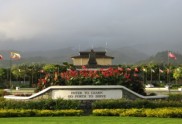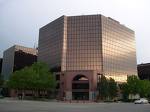Members of The Church of Jesus Christ of Latter-day Saints (also called the LDS Church or the Mormon Church) believe seeking a good education is a direct commandment from God. In Doctrine and Covenants Section 109, verse 7, it reads, “And as all have not faith, seek ye diligently and teach one another words of wisdom; yea, seek ye out of the best books words of wisdom, seek learning even by study and also by faith.” The Saints always tried to observe this commandment, but when the time came for them to head West, they felt a special need in heeding it. They were moving to an isolated wilderness and realized everything they needed in order to teach their children they would have to bring with them. In December 1847, a general epistle was issued to the Saints from Winter Quarters urging them to bring every educational thing they could with them:
 “It is very desirable that all the Saints should improve every opportunity of securing at least a copy of every valuable treatise on education—every book, map, chart, or diagram that may contain interesting, useful, and attractive matter, to gain the attention of children, and cause them to love to learn to read; and also every historical, mathematical, philosophical, geographical, geological, astronomical, scientific, practical, and all other variety of useful and interesting writings, maps, &c., to present to the General Church Recorder, when they shall arrive at their destination, from which important and interesting matter may be gleaned to compile the most valuable works, on every science and subject, for the benefit of the rising generation” (Millennial Star, 10:85).
“It is very desirable that all the Saints should improve every opportunity of securing at least a copy of every valuable treatise on education—every book, map, chart, or diagram that may contain interesting, useful, and attractive matter, to gain the attention of children, and cause them to love to learn to read; and also every historical, mathematical, philosophical, geographical, geological, astronomical, scientific, practical, and all other variety of useful and interesting writings, maps, &c., to present to the General Church Recorder, when they shall arrive at their destination, from which important and interesting matter may be gleaned to compile the most valuable works, on every science and subject, for the benefit of the rising generation” (Millennial Star, 10:85).
The response of the Saints resulted in a free public library which was opened in Salt Lake City in 1850. Materials also enabled Mary Dilworth to open the first school in late 1847. Her classes developed into classes for adults as well, when more material was obtained, and in 1850 (before Utah was even organized as a territory of the United States), the University of Deseret was formed, today the University of Utah. Though the university struggled to grow for several years, due to resources, by 1876, it had developed into a sound organization.
In addition to education, such as they were able to have in each community, the Saints also had entertainment which upheld LDS values. “Men are, that they might have joy” (2 Ne. 2:25) the Book of Mormon teaches. Mormon doctrine also teaches that the body is not a prison, is not a negative thing, but that the body, combined eternally with the spirit, creates the soul and the means for receiving a fullness of joy. Thus dancing, sports, and theater were all encouraged activities, and each community had a building which they could use for these purposes.
After Utah was officially a United States territory, however, and as people of other faiths began joining their communities, there began to be conflict in the school systems. The Church’s schools all taught spiritual matters as well as secular, but when the schools came under federal jurisdiction, scriptures were no longer to be taught in public schools and classes were forbidden to be held in church buildings. In many areas the Church still held private LDS schools, but the costs became too much, especially since all the citizens had to pay a school tax anyway. With prejudices already building, many Protestant congregations began opening free private schools, and many of the Saints’ children could not afford to not attend these schools.
To try and create better spiritual learning environments for the Saints, the Church began to organize academies. The first was Brigham Young Academy, which was established in 1875 in Provo, Utah. Another followed in Logan, and then local leaders were instructed to set up an academy in each stake (area made up of several wards, under the leadership of a stake president). By 1907, thirty-five academies had been organized, but many of them did not last very long because they lacked the necessary finances. The Church kept eight of the academies open, though, and expanded them to train new teachers. These academies were: Brigham Young University in Provo; Brigham Young College in Logan; Weber Normal College in Ogden; Dixie Normal College in St. George; Snow Normal College in Ephraim; Ricks Normal College in Rexburg, Idaho; Mesa Normal College in Arizona; and Juarez Academy in Mexico. Most of these are still in operation today as fully accredited colleges and universities, though some of them were turned over to the state under the condition they would still be run as colleges.
The Church did not neglect spiritual teaching, though. In 1912, the Church began to build facilities adjacent to high schools to establish seminaries. Where permission was granted, high school students were released for one period each day to attend a religion class. If permission was not granted by the school for a release time, then early-morning classes were held before the high school began classes. The program was successful and the Church eventually built it up in its stakes and wards all around the world. Where it is impossible or highly impractical for this arrangement, a home study program is available for students.
With the success of the seminary program, the Church expanded to create an institute program for college-level students. The Church realized it could not build academies or colleges in every large town in the United States, so it opted for this route. By 1970, both programs had been implemented in all fifty of the United States, to provinces in Canada, to England, Germany, Argentina, Brazil, New Zealand, and Australia. Institute programs are now available in most towns and cities with institutions of higher learning.
 Brigham Young University in Provo continued to grow and is now the largest church-related university in America. Most faculty are members of the Church. The university enforces a high moral code and is able to teach many secular principles from a religious viewpoint. Now the enrollment reaches about 25,000, and the school continues to improve in quality of education. The school is now considered “very selective” with its applicants, and is often found in the top 50 schools in business and law, according to U.S. News and World Report. BYU also has innovative engineering and art animation programs that interface with companies in the marketplace. Other Church universities include BYU-Hawaii and BYU-Idaho.
Brigham Young University in Provo continued to grow and is now the largest church-related university in America. Most faculty are members of the Church. The university enforces a high moral code and is able to teach many secular principles from a religious viewpoint. Now the enrollment reaches about 25,000, and the school continues to improve in quality of education. The school is now considered “very selective” with its applicants, and is often found in the top 50 schools in business and law, according to U.S. News and World Report. BYU also has innovative engineering and art animation programs that interface with companies in the marketplace. Other Church universities include BYU-Hawaii and BYU-Idaho.
 Established as the Church College of Hawaii in 1955, BYU-Hawaii was built with the purpose of offering educational opportunities to Pacific Islanders who might otherwise not have such an opportunity. In 1963, the Polynesian Cultural Center was established in order to preserve many of the Pacific cultures. Mormons believe the Pacific Islanders are descendants of the Book of Mormon peoples and have reached out to them with the gospel. The Church has been well received among the Islanders, and many attend BYU-Hawaii and work at the PCC to earn money to put themselves through school before returning to their native islands.
Established as the Church College of Hawaii in 1955, BYU-Hawaii was built with the purpose of offering educational opportunities to Pacific Islanders who might otherwise not have such an opportunity. In 1963, the Polynesian Cultural Center was established in order to preserve many of the Pacific cultures. Mormons believe the Pacific Islanders are descendants of the Book of Mormon peoples and have reached out to them with the gospel. The Church has been well received among the Islanders, and many attend BYU-Hawaii and work at the PCC to earn money to put themselves through school before returning to their native islands.
 BYU-Idaho was originally founded in 1888 as the Bannock Stake Academy and later became known as Ricks Normal College, and finally as Ricks College, which it remained until 2001, when it became BYU-Idaho. Now a four-year university, BYU-Idaho still offers many associate degrees. Now all three universities run on the same three-track system of fall, winter, and spring-summer trimesters, rather than the standard fall and winter semesters. Each university is respected and continues to offer valuable educations to its students in an enriching, spiritual environment.
BYU-Idaho was originally founded in 1888 as the Bannock Stake Academy and later became known as Ricks Normal College, and finally as Ricks College, which it remained until 2001, when it became BYU-Idaho. Now a four-year university, BYU-Idaho still offers many associate degrees. Now all three universities run on the same three-track system of fall, winter, and spring-summer trimesters, rather than the standard fall and winter semesters. Each university is respected and continues to offer valuable educations to its students in an enriching, spiritual environment.
 LDS Business College, located in Salt Lake City, Utah, is the last Church-owned college. Originally founded in 1886 as the Salt Lake Academy, LDS Business College is the only commercial school in America owned and operated by a religious body to have been admitted to the National Association of Accredited Commercial Schools.
LDS Business College, located in Salt Lake City, Utah, is the last Church-owned college. Originally founded in 1886 as the Salt Lake Academy, LDS Business College is the only commercial school in America owned and operated by a religious body to have been admitted to the National Association of Accredited Commercial Schools.
The Church of Jesus Christ of Latter-day Saints also runs elementary and secondary schools around the world in areas where other schooling is not available to its members. Its focus on learning reaches beyond colleges and universities and encourages all its members to study and read on their own, continuing to learn and teach throughout their lives.
In 2001, President Gordon B. Hinckley announced the founding of the Perpetual Education Fund (PEF). This program was inspired by the Perpetual Emigration Fund, which made the immigration of thousands of Saints possible in the early days of the Church. While the Saints were gathering to Zion, there were many poor who could not afford the journey to Utah. The Church organized a program in which individuals could be lent money for passage, which money they could pay back after their arrival and having worked in whatever capacity they were able. The Perpetual Emigration Fund was discontinued when there was no longer a need for it. Today, however, the gathering to Zion has been redefined from gathering to Utah to helping build Zion (a community of the pure in heart) in one’s own country. The Church of Jesus Christ of Latter-day Saints is now an international church and has recognized that many of its members are stuck in a cycle of poverty. To help them break this cycle, the PEF was formed. In the workings of the PEF, worthy individuals are granted a loan to pursue an education in a specific field. After gaining their desired education and obtaining gainful employment, these individuals repay their loan, with a low interest, to the fund, thus enabling others in need to benefit from the program as well. The PEF is funded largely by donors and costs the Church nearly nothing. As it is used correctly by individuals, it will grow and continue to allow others to benefit as well.
“Where there is widespread poverty among our people, we must do all we can to help them to lift themselves, to establish their lives upon a foundation of self-reliance that can come of training. Education is the key to opportunity. This training must be done in the areas where they live. It will then be suited to the opportunities of those areas. And it will cost much less in such places than it would if it were done in the United States or Canada or Europe,” said President Hinckley.
LDS Newsroom continues to report success stories of those who have benefited from the PEF. This LDS program has been functioning and blessing the lives of people ever since and continues to do so today. Mormons continue finding ways to fulfill the commandment to seek learning and wisdom, but they do not neglect helping others to do so as well.
Sources:
The Latter-day Saints: A Contemporary History of the Church of Jesus Christ, William E. Berrett, 1985.
Twitter •


 Watch a video about the restoration of the gospel on lds.org
Watch a video about the restoration of the gospel on lds.org